Servers products are moving forward to the PCIe Gen4 overall. The industry’s demand for 100GbE port network switches stays strong. This article introduces the Arista DCS-7060CX-32S-R data center network switch with 32x100GbE QSFP28 & 2x SFP+ port from the perspectives of its external & internal design, technical specifications, and supported operating system. In an era that which the white box network switches are growing, it is still worthwhile and meaningful to take a good look at these Arista Networks Dcs-7060cx-32s.

∆ Figure1 The Internal Structure Display of Arista DCS-7060CX-32S
1. External Designs in Arista DCS-7060CX-32S
The case of the Arista DCS-7060CX-32S switch is 1U tall, applying to a standard 19-inch rack. What you can notice easily in the following picture is the 32*100G QSFP28 IO ports in the front of the case. 2 additional SFP+ port is provided on the left side of the front panel. On the right are two RJ45 network ports for management and a USB port for accessing log information.

∆ Figure2 The Front Board of Arista DCS-7060CX-32S
There are four hot-swappable fans and two primary power modules on the rear of the Arista DCS-7060CX-32S network switch case. All the modules in the rear of the case are designed with a red hand grip, indicating that there will be hot air blowing out of the rear in such a case with built-in Rear-to-Front Air ducts.

∆ Figure3 The Rear of Arista DCS-7060CX-32S 32x100GbE QSFP28 Switch
2. Internal Designs in Switch Case
As one of the typical box network switches, the designs both in the front and rear of Arista Port Network Switch DCS-7060CX-32S are pretty simple. The featured design lies in the switch QSFP case inside. When you open the upper cover of the case, the switchboard with switch chips and the main control panel with the control CPU is displayed clearly in front of you.

∆ Figure4 Internal Design of Arista DCS-7060CX-32S
3. Tomahawk Chip in DCS-7060CX-32S
The DCS-7060CX-32S switch uses the first-generation Tomahawk chip introduced by Broadcom in 2014, which can provide bidirectional 6.4Tbps switching capacity and 3.3Bpps data packet processing capacity. You may believe that it is making a fuss to discuss such a capacity switching chip as far as today is concerned. But it was the max-storage switching chip back in 2015 in data center switches. For today’s users, data center switches equipment of this storage level can be obtained at a relatively lower price. Behind the QSFP cages, there is the Broadcom Tomahawk switch ASIC in the middle of the switching PCB. This is a 6.4T switch chip for bi-directional 32x 100GbE QSFP28 port traffic and is capable of around 3.3Bpps.
|
ARISTA 7060X and 7260 Series|Technical Specifications |
|||||
|
Specifications |
|||||
|
Switch Model |
7060CX2-32S |
7060SX2-48YC6 |
7060CX-32S |
7260CX-64 |
7260QX-64 |
|
Ports |
32xQSFP28 2xSFP+ |
48xSFP28 6xQSFP28 |
32xQSFP28 2xSFP+ |
64xQSFP28 2xSFP+ |
64xQSFP+ 2xSFP+ |
|
Max 100Gbe Ports |
32 |
6 |
32 |
64 |
0 |
|
Max 40Gbe Ports |
32 |
6 |
32 |
64 |
64 |
|
Max 25Gbe Ports |
128(4x25G) |
72(48xSFP28 & 6 4x25G) |
128(4x25G) |
256(4x25G) |
0 |
|
Max 10Gbe Ports |
130(32 4x10G & 2 SFP+) |
72(48xSFP+& 6 4x10G) |
130(32 4x10G & 2 SFP+) |
258(64 4×10 & 2xSFP+) |
2 |
|
Max 1Gbe Ports |
2 |
48 |
2 |
2 |
2 |
|
Throughput |
64Tbps |
36Tbps |
64Tbps |
12.8Tbps |
5.12Tbps |
|
Packet/Second |
3.3Bbps |
2.7Bbps |
3.3Bbps |
9.52Bbps |
3.3Bbps |
|
Latency |
450ns |
450 |
450 |
550 to1500ns |
550ns |
|
CPU |
Multi-Core x86 |
Multi-Core x86 |
Multi-Core x86 |
Dual-Core i7x86 |
Multi-Core x86 |
|
System Memory |
8Gigabytes |
8Gigabytes |
4Gigabytes |
8Gigabytes |
4Gigabytes |
|
Flash Storage Memory |
4Gigabytes |
4Gigabytes |
4Gigabytes |
4Gigabytes |
4Gigabytes |
∆ Figure5 Technical Specifications of Arista 7060X and 7260 Series
4. Featured Designs in DCS-7060CX-32S
● Heatsink in Tomahawk Chip
A few featured designs in DCS-7060CX-32S are referential to today’s switching products research and development. The first is the heatsink used by Arista on the Broadcom Tomahawk chip. Unlike the common chip heatsinks, finned heatsinks are applied to the switching chip in the Arista DCS-7060CX-32S data center network switch. The heatsink above the chip is connected to a large heatsink with denser fins on both sides through a heat pipe so that the length of the entire heat-sink reaches 15 inches. It is obvious that the switching chip can have a great heat dissipation performance with such a huge heatsink system.

∆ Figure6 Finned Heatsinks within Arista DCS-7060CX-32S Switch
Under the huge heatsink, there are some chips with low power apart from those high-power switching chips. You can notice Intel/Altera Cyclone FPGA chips at the margin below the heatsinks.

∆ Figure7 Chiplets Under the Heatsinks of Arista DCS-7060CX-32S Switch
● Connection of Primary Power Modules
In the rear of the switch case, the control panel of the entire system lies between the two primary power modules on the left and right sides. The following picture clearly depicts that the control panel and the switching board are connected through a high/low-speed connector.

∆ Figure8 Internal Control Panel in Arista DCS-7060CX-32S Switch
The second featured design is the power supply inside the Arista DCS-7060CX-32S network switch, which is shown in Figure 9. Unlike the design that the control panel supplies power to the switching board, Arista inserted the primary power modules directly to the switching board, providing the high-power switch chip with power. While the control panel with low power consumption obtains power indirectly from the switchboard through the connector.

∆ Figure9 Connectors of Primary Power Modules in Arista DCS-7060CX-32S
The DCS-7060CX-32S switch control panel does not use Intel C2000 CPU as Celestica did but AMD GX-424CC SoC embedded CPU. Though both Intel C2000 CPU and AMD GX-424CC SoC CPU are x86 system platforms for managing the switch, the latter is more cost-effective. There are 2 DDR3 slots next to AMD CPU, allowing users to configure different memory storage according to their needs.

∆Figure10 AMD CPU in the Control Panel of Arista DCS-7060CX-32S Switch
● 2280 M.2 slot Vacated in Control Panel
The 2280 M.2 slot vacated in the control panel of the DCS-7060CX-32S Arista network switch is the third featured design, which is somewhat similar to a server and additional data storage space can be obtained on the control board. A hot-pluggable interface is designed in the part connected to the fan module in the control panel. Guided by the red plastic clips, the fan module can be easily plugged in and unplugged from the control board.

∆ Figure 11 Connectors for Fan Modules in Arista DCS-7060CX-32S
5. Power Module of DCS-7060CX-32S in Datasheet
According to the spec sheet of the DCS-7060CX-32S switch, this device supports a primary power supply module with a maximum power of 500W. But Arista is equipped with Delta’s 495W, 80Plus platinum primary power supply module in actual switch devices. The maximum power of this Arista DCS-7060CX-32S switch is 333W. Therefore, the 5W difference in the primary power module is more of a curiosity rather than a cause for concern.

∆ Figure 12 495W PSU Primary Power Module in Arista DCS-7060CX-32S Switch
6. Arista Operating System Supported by the Switch
As one of the Arista switches series products, DCS-7060CX-32S supports EOS operating system. But that if a switch can run into the world of open networking is an indicator to evaluate the degree of openness for a hardware device in the growing white-boxing trend of network equipment. You can check out the DCS-7060CX-32S switch in the list of Arista SONIC on GitHub.

∆ Figure 13 Arista DCS-7060CX 32S SONiC Supported Devices From The Data Sheet
Conclusion
As mentioned at the beginning of this article, when server products fully enter the PCIe Gen4 era, the x16 PCIe slot can support two 100GbE network ports, which stimulate users’ demand on more switch devices that provide 100GbE ports, or 400GbE ports. The mature technology applied in switching chips and switch devices allows the new generation servers to be connected to the entire network at a lower cost. Meanwhile, as these network devices support the SONIC operating system, their price and the cost of usage will be further reduced.
Related Products:
-
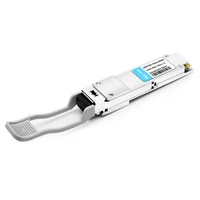 Arista Networks QSFP-100G-SRBD Compatible Dual Rate 40G/100G QSFP28 BIDI 850nm & 900nm 100m LC MMF DDM Optical Transceiver
$449.00
Arista Networks QSFP-100G-SRBD Compatible Dual Rate 40G/100G QSFP28 BIDI 850nm & 900nm 100m LC MMF DDM Optical Transceiver
$449.00
-
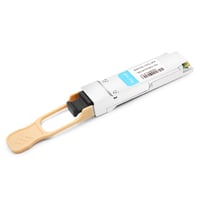 Arista Networks QSFP-100G-SR4 Compatible 100G QSFP28 SR4 850nm 100m MTP/MPO MMF DDM Transceiver Module
$40.00
Arista Networks QSFP-100G-SR4 Compatible 100G QSFP28 SR4 850nm 100m MTP/MPO MMF DDM Transceiver Module
$40.00
-
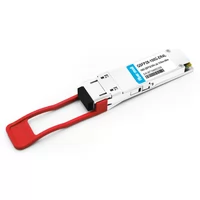 Arista Networks QSFP-100G-ERL4 Compatible 100G QSFP28 ER4 Lite 1310nm (LAN WDM) 40km with FEC, 30km without FEC LC SMF DDM Transceiver Module
$800.00
Arista Networks QSFP-100G-ERL4 Compatible 100G QSFP28 ER4 Lite 1310nm (LAN WDM) 40km with FEC, 30km without FEC LC SMF DDM Transceiver Module
$800.00
-
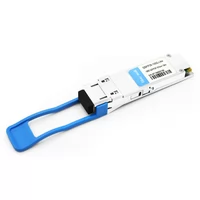 Arista Networks QSFP-100G-LR4 Compatible 100G QSFP28 LR4 1310nm (LAN WDM) 10km LC SMF DDM Transceiver Module
$285.00
Arista Networks QSFP-100G-LR4 Compatible 100G QSFP28 LR4 1310nm (LAN WDM) 10km LC SMF DDM Transceiver Module
$285.00
-
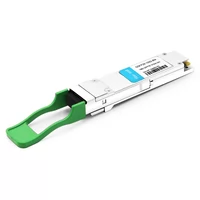 Arista Networks QSFP-100G-CWDM4 Compatible 100G QSFP28 CWDM4 1310nm 2km LC SMF DDM Transceiver Module
$110.00
Arista Networks QSFP-100G-CWDM4 Compatible 100G QSFP28 CWDM4 1310nm 2km LC SMF DDM Transceiver Module
$110.00
-
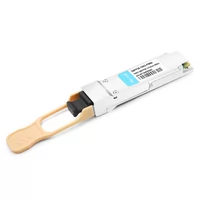 Arista Networks QSFP-100G-PSM4 Compatible 100G QSFP28 PSM4 1310nm 500m MTP/MPO SMF DDM Transceiver Module
$180.00
Arista Networks QSFP-100G-PSM4 Compatible 100G QSFP28 PSM4 1310nm 500m MTP/MPO SMF DDM Transceiver Module
$180.00
-
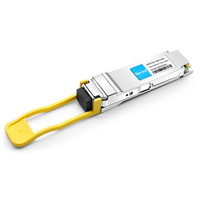 Arista Networks QSFP-100G-DR Compatible 100G QSFP28 Single Lambda DR 1310nm 500m LC SMF with FEC DDM Optical Transceiver
$180.00
Arista Networks QSFP-100G-DR Compatible 100G QSFP28 Single Lambda DR 1310nm 500m LC SMF with FEC DDM Optical Transceiver
$180.00
-
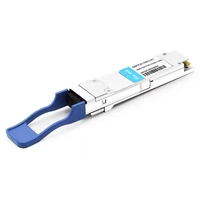 Arista Networks QSFP-100G-LR Compatible 100G QSFP28 Single Lambda LR 1310nm 10km LC SMF with FEC DDM Optical Transceiver
$265.00
Arista Networks QSFP-100G-LR Compatible 100G QSFP28 Single Lambda LR 1310nm 10km LC SMF with FEC DDM Optical Transceiver
$265.00
-
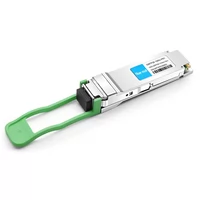 Arista Networks QSFP-100G-FR Compatible 100G QSFP28 Single Lambda FR 1310nm 2km LC SMF with FEC DDM Optical Transceiver
$215.00
Arista Networks QSFP-100G-FR Compatible 100G QSFP28 Single Lambda FR 1310nm 2km LC SMF with FEC DDM Optical Transceiver
$215.00
